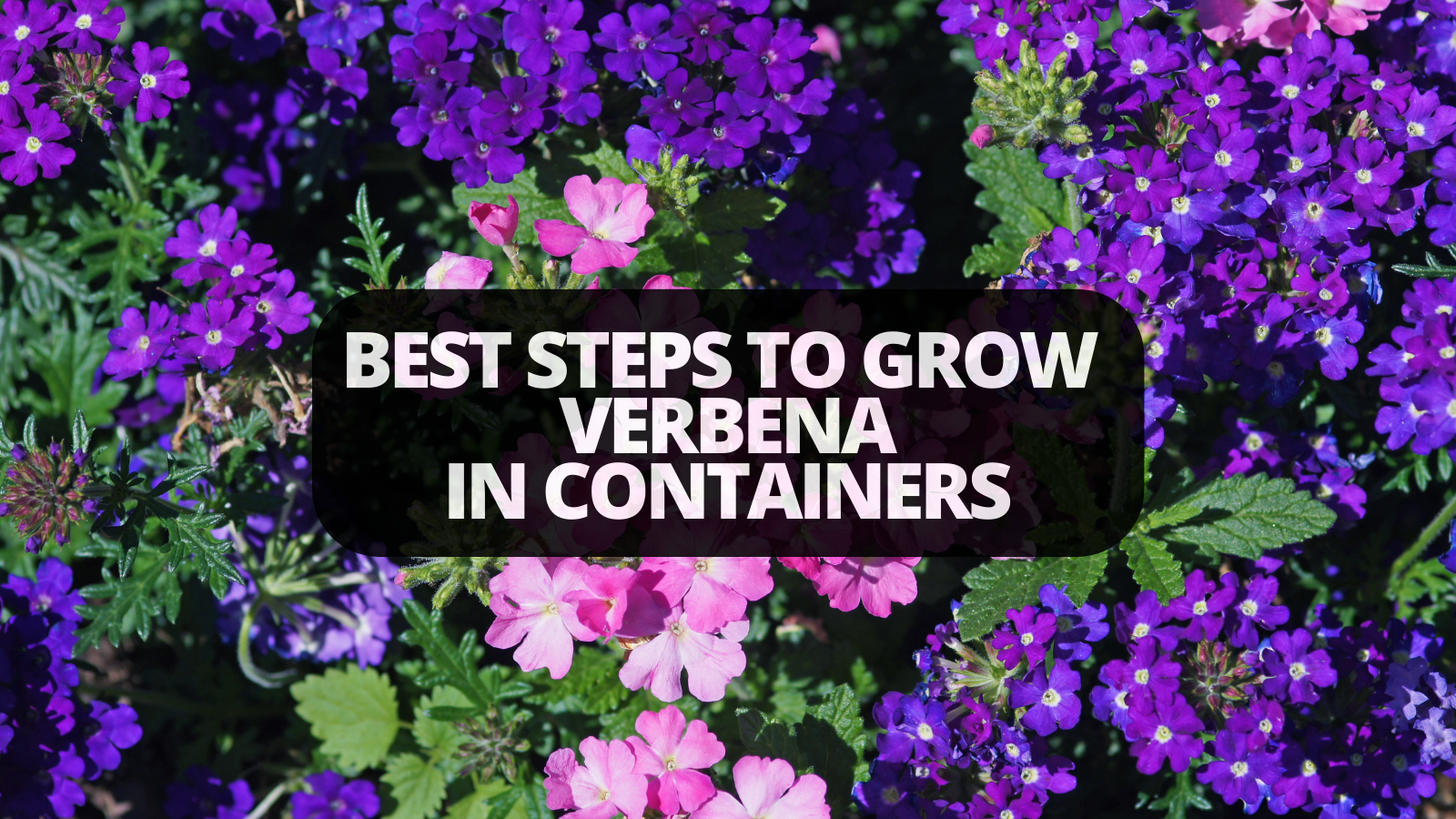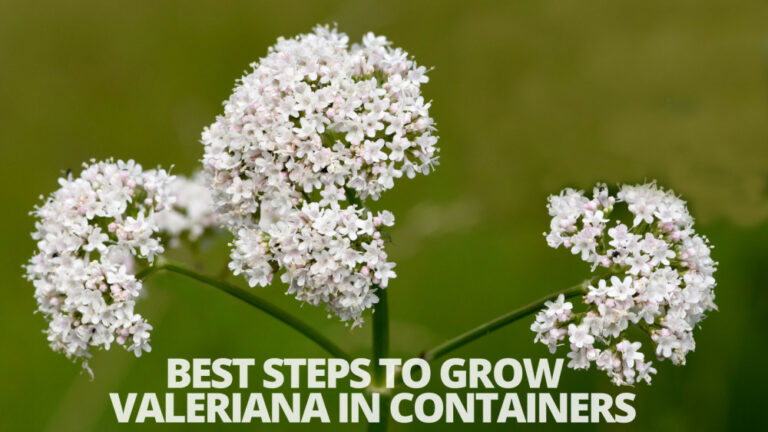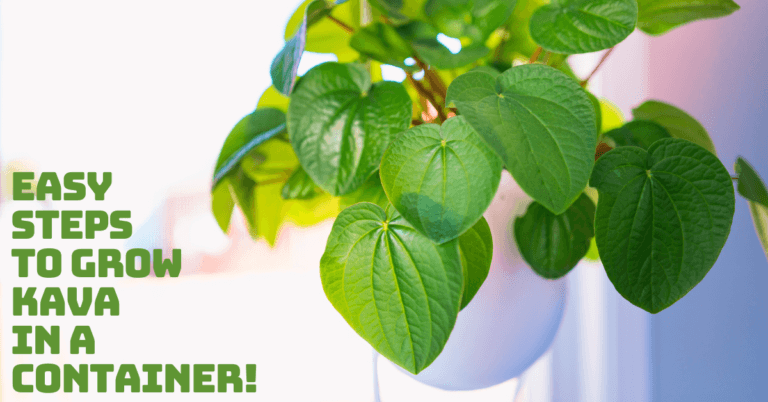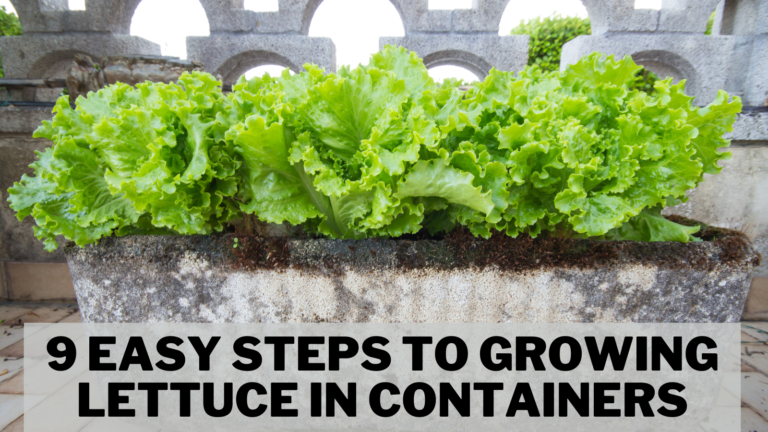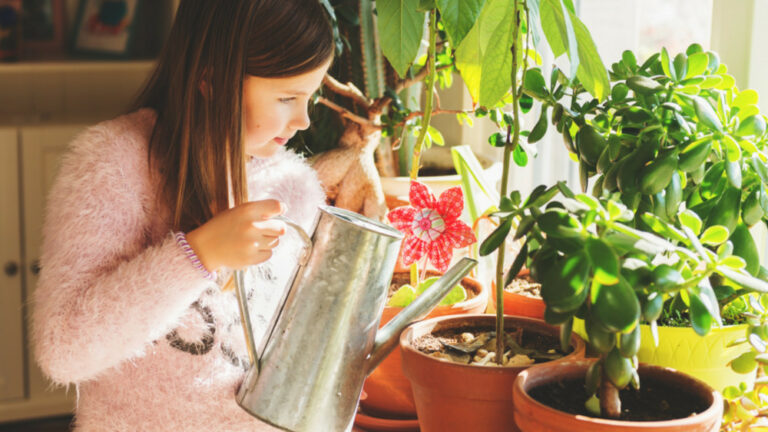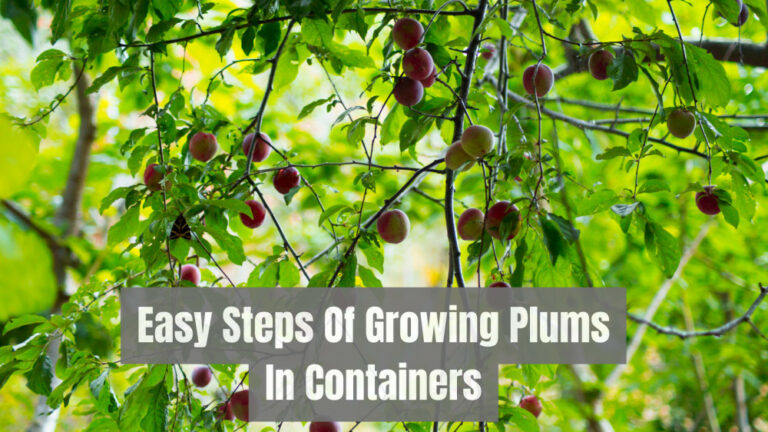Best Steps To Grow Verbena In Containers
Best Steps To Grow Verbena In Containers
Verbena is a lovely flowering plant. It primarily grows as an annual plant in most regions, with vibrantly coloured flowers and dark green foliage.
Verbena is typically grown in pots, containers, hanging baskets, and garden borders.
After being established, verbena plants don't need much, but you must maintain appropriate conditions for beautiful flowers. Let’s get started to grow verbena in containers.
History & Origin Of Verbena
Verbena is a genus belonging to the genera Verbena and Glandularia. The bulk of these plants is indigenous to tropical and subtropical Americas.
They typically have opposite, toothed, lobed, or divided leaves. Before a taxonomic revision, all verbena species belonged to the Verbena; however, several species have since transferred to the closely related genus Glandularia.
A square-stemmed creeping plant with flat heads of phlox-like blooms in various colours, the common garden verbena (Glandularia hybrida, originally Verbena hybrida) is a common garden plant.
Garden blooms of the clump verbena, also known as rose verbena (Glandularia canadensis, originally V. canadensis), are occasionally grown.
Most of the real Verbena species in North America are vervains, commonly known to be low-growing, weedy plants with tiny flowers.
The flower spikes of the blue vervain range in colour from blue to purple. (V. hastata), which grows to a height of 1.5 meters (5 feet). V. officinalis, sometimes known as the herb of the cross, is a species native to Eurasia.
Vervain was a common ingredient in the potions used by witches and magicians during the Middle Ages.
Vervain received the name herba veneris, or “herb of love,” since it was employed in folk medicine as an aphrodisiac and used for protection.
The herb was highly respected in many European cultures and regarded as almost a panacea for treating gastrointestinal organs, the lungs, and headaches.
Types Of Verbena
Verbenas are a true garden gem because of their vibrant colours. Some species trail, while others develop mounds.
View the varieties of verbenas here. To grow verbena in containers, you need to know the types.
1. Trailing Verbenas
As their name implies, verbena species known as “trails” grow in a lengthy, outward-facing pattern.
These are typically cultivated in hanging pots, window boxes, and locations close to the edges of walls so that they can grow over them as they do.
Trailing verbenas require regular pruning to keep the vines in good form. The dead stems must be cut and eliminated quickly to prevent rot.
There are numerous hues of trailing verbenas, including pure white, white with pink lines, dark purple, vivid pink, rich crimson, delicate lavender, and others.
2. Upright Verbenas
Verbenas that grow straight and upright, as opposed to those that trail, are called upright verbenas.
Their flower-laden stalks, which can grow up to 6 feet tall, will undoubtedly attract everyone's attention from a distance.
Upright verbena species work well for creating permanent borders or growing along fences.
3. Moss Verbenas (Verbena Tenuisecta)
Moss verbenas, also known as Verbena tenuisecta, is so named because of its delicate foliage, which has small leaves resembling moss.
The smallest of all the verbena species, growing to an average height of about 5 to 6 inches, this species still has a lovely appearance.
In a typical garden, verbenas are frequently grown next to (or in between the rocks in) paths, even though they are most effective in rock gardens.
Although they can withstand frost, they only bloom in the late summer and early fall.
4. Annual Verbenas
Since verbenas are essentially perennial plants, they typically last up to two years or longer.
However, wide varieties of verbena only bloom once, living about a year after planting before fading away. However, gardeners were unable to let that stand in their way.
Scientists developed the verbena type known as “annual” to meet the demand for growing these gorgeous charmers. Annual verbenas live as their name implies for an entire year.
However, these hybrids bloom virtually all year round instead of mainly in the summer, like most naturally occurring kinds.
Therefore, choosing annual verbenas is your best option if you're seeking plants that will provide your landscape colour all year.
5. Brazilian Verbena (Verbena Brasiliensis)
Although the true Brazilian verbena is an entirely different species, the purple top verbena is frequently referred to as the Brazilian verbena or Brazilian vervain.
The species is indigenous to South America, more specifically Brazil, but it has quickly spread to other regions and is now regarded as an invasive weed.
The Brazilian Verbena is a low-lying shrub since it is a herbaceous plant. This verbena variety, which typically has purple hues, produces dense clusters of tubular flowers with five lobes and short, indented leaves.
Brazilian verbena is commonly found in natural settings and backyard gardens in many regions of North America, including Oregon, North and South Carolina, Tennessee, Florida, Virginia, Hawaii, and many more.
Grow Verbena In Containers
The diverse plant genus Verbena is primarily indigenous to South America. The quantity of nectar-rich blooms more than makes up for their tendency to be short-lived.
The well-known Verbena bonariensis, its shorter-growing cultivar “Lollipop,” and the architectural Verbena hastata and Verbena rigida, which thrives in pots, are all hardy verbena types.
The ideal way to cultivate tender verbenas is as annuals, and they look great in hanging baskets and bedding arrangements.
Choose The Right Container
It's essential to use a container with drainage when planting verbena in a container. Since verbena dislikes being wet for an extended period, the pot's drainage holes let the soil and plant dry out in between watering.
Soil To Grow Verbena in Containers
These plants prefer dry ground with a pH range between acidic and neutral (5.8 to 7.2). Apart from needing well-draining soil, verbena has a few requirements. To lighten dense soils, add compost or leaf mould. Heavy clay can cause root rot.
Grow Verbena From Seed
Most verbenas are hybrids. Therefore, you can't “grow true” verbenas from the seeds you collect from garden plants. Instead, use commercial sources that you purchase that are created in a tightly supervised greenhouse.
They must be started 12 to 14 weeks before the typical last frost date to guarantee bloom by early summer.
Wrap the seeds in a moist paper towel and put them in a plastic bag. Plant them after seven days in the refrigerator in cell trays with a commercial seed-starter mixture.
Add a thin layer of the seed-starter mixture after pressing the seed into the soil. To keep the starter mix moist, mist it.
Then, cover the tray and put it somewhere dark and out of the sun, where the temperature should be around 75 degrees.
After 21 to 30 days, when the seeds start to sprout, remove the cover and place the tray in full sunlight.
When the seedlings have several sets of true leaves, they can be transplanted into pots filled with potting soil or right into the garden.
Sunlight
Expose verbena to the sun's rays. In areas that receive shade, flowering will be drastically reduced.
The minimum amount of time in direct sunlight this plant requires daily is six hours, but eight to ten hours is much better.
Water
The parent species of many of these hybrids are indigenous to dry prairies or Mediterranean regions and, therefore, have similar water requirements. As they grow, keep plants uniformly watered.
Once fully grown, these plants require an average amount of water (1/2 to 1 inch per week), but they may survive brief droughts.
Although the botrytis blight will spread through wet plants, spider mites may attract plants experiencing drought stress.
Temperature and Humidity
Hybrid verbenas perform well in almost any climate when grown as annuals, though they may suffer during the hottest summer.
Most hybrids are hardy in zones 9 to 10, while some are only in zone 7 when cultivated as short-lived garden perennials.
Fertilizer
Although verbenas don't require much food, plants benefit from a monthly dose of balanced, slow-release flower fertilizer to help them maintain the bloom display, which can continue from spring until winter. Follow the recommendations on the product package for fertilizer usage.
Pruning
Throughout the growing season, shear back verbena plants once or twice to promote new blooms and keep the plants full and aesthetically pleasing. By deadheading spent flowers, more flowers will bloom.
Propagating Verbena
Cutting off stem segments and re-rooting them is the classic vegetative method for propagating hybrid garden verbenas.
This strategy has been tried and tested and is effective for many herbaceous plants.
Taking stem cuttings of verbenas in the fall and rooting them indoors before potting them up to prepare for springtime outdoor transplanting can be an excellent way to keep plants alive through the winter. This is how you do it:
- Cut 4- to 6-inch cuts from the ends of healthy stems using clean, sharp pruners. The bottom third of the cutting must clear leaves before being dipped into rooting hormone.
- In a small pot, fill with a porous rooting medium like peat moss (or a commercial potting mix that contains peat) mixed with equal parts sand or perlite. Bury the exposed portion of the stem while planting the cutting in the potting soil. Water the pots gently to moisten the potting mix thoroughly.
- Set the pot somewhere bright but out of direct sunlight and cover it with a plastic cover (or put it in a loose plastic bag). Periodically check the cutting and add moisture to the potting mix if necessary.
- Start testing the cutting by gently pulling on the stem after a few weeks have passed. Once you start to experience resistance, you'll know roots have become established once new growth becomes apparent; transplant plants into the garden or larger pots filled with potting soil.
Potting And Repotting Verbena
Verbena is frequently seen in hanging baskets containing various flowers because they make good “spillers” hanging over the sides of the basket.
Use any all-purpose peat-based potting mix for planting in any well-draining container (any material will do).
For indoor overwintering, verbena that is already growing in the ground can also be potted up.
Since they are grown as annuals, potted verbenas frequently don't need to be replanted; instead, they are removed at the end of the growing season.
However, as potted verbenas are essentially warm-climate perennials, pots can be brought inside and left flourishing throughout winter.
If you do, trim back the leaves by a third before transplanting them, and provide them with space inside that receives as much sunlight as possible.
Verbenas do not, however, make suitable long-term houseplants due to their limited perennial life period.
Overwintering
Verbena in pots may be overwintered. Unless you pot it by digging up the entire plant, unpotted verbena will probably die off by the first hard frost (when temperatures drop below freezing). What you should do is:
- Reduce the plant's size by more than 50%. Dig it up carefully, then cut the roots in half.
- Locate a container and fill it with potting soil so there are a few inches around the root ball. Plant it at the same depth the verbena was growing in the ground.
- Find the sunniest indoor location and place the newly potted plant there. For the first few weeks indoors, sprinkle with water, then check often and water as necessary.
- Additionally, look for bugs because typical houseplant pests like aphids can affect indoor plants.
- Trim back the plant as the final spring frost approaches to encourage new growth. You can take the container outside or transplant the verbena in the garden once the last spring frost has passed and nighttime lows are consistently above 50 degrees Fahrenheit.
Encouraging Verbena To Bloom
If their basic cultural requirements—a lot of sun, well-draining soil with moderate moisture, and light frequent feeding—are met, hybrid verbenas nearly always blossom lavishly.
Giving a plant a good “haircut” by severely trimming it and adding a healthy dose of balanced fertilizer is frequently the answer when it doesn't blossom.
Common Pests & Diseases Of Verbena
To grow verbena in containers, you may also face some problems with pests and diseases.
Like most plants, Verbena is prone to fungus problems in moist environments. Avoid this by using wise water management practices and promoting adequate air circulation.
To allow plants to dry before nightfall sets in, use a soaker hose or water in the morning. If your plants contract a fungus, such as powdery mildew, a general-purpose fungicide should work until the situation is dry.
Unfortunately, there is a long list of potential pests, and insects seem to be the main cause of problems with this flower.
The most frequent pests include aphids, caterpillars, gall midges, leaf miners, mealybugs, mites, scales, and whiteflies.
A bar of insecticidal soap or the fungicide mentioned above can be applied if you can't stand having these pests on your plant.
However, consider that the pests might not be a major issue before spraying.
Due to the prevalence of pesticides and other toxic chemicals in our environment, every gardener should know the acceptable loss.
We'll be better off in the long run if we allow a few aphids to feast on our annuals before spraying on the insecticides.
Common Problems With Verbena And Solutions
Gardeners frequently struggle with finding the correct watering schedule when producing hybrid verbenas.
If a plant receives too much water, it may develop root rot; if it gets too little water, it may dry out and wither away.
Although this plant prefers dry soils and can withstand brief droughts, prolonged drought lasting longer than a few weeks in warm weather can be fatal. It can be challenging to time the watering of these plants.
Ordinarily, 1 inch of water applied once a week is sufficient; however, this amount may be excessive for plants grown in deep soils with poor drainage.
Growing successful experts frequently discover that the finest approach is carefully monitoring the plant and withholding water until the leaves begin curling.
Sometimes, verbenas grow excessively leggy and sparse. Here, the best course of action is to severely trim and feed the plant, which will prompt rapid new growth and a rush of flowers.
Benefits Of Vervain
1. Anticancer
According to research conducted in test tubes and on animals, Vervain's glycosides, triterpenoids, and essential oils may assist in slowing tumour growth and cause the death of malignant cells.
In rat research, high dosages of vervain extract, at 18 grams per pound (40 grams per kilogram) of body weight, reduced tumour growth by more than 30% compared to controls.
Verbenosides A and B, two kinds of glycosides, and triterpenoids in this anti-tumour effect.
Additionally, citral, a crucial ingredient in vervain essential oil, has anticancer properties that have been demonstrated to cause programmed cell death.
One test-tube study discovered that vervain essential oil boosted the mortality of rogue immune cells taken from people with chronic lymphocytic leukemia from 15-52% at a concentration of 0.01%, indicating that it may be helpful for the creation of novel treatments.
2. Anti-Inflammatory
As I frequently point out, inflammation is the primary cause of most illnesses. Numerous frequent, persistent, and even serious health issues can be resolved by reducing inflammation in the body.
Vervain's capacity to reduce inflammation both internally and externally ranks among its top advantages.
The effects of several vervain extracts (extracted differently), when administered orally to animal subjects, were studied in research published in the international journal Planta Medica.
The study revealed that all vervain extracts “induce a great anti-inflammatory effect.” Additionally, the extracts showed a capacity to lessen gastrointestinal harm.
According to a study published in the Journal of Ethnopharmacology, vervain can have anti-inflammatory and pain-relieving properties when administered topically.
3. Improves Gum Health
Vervain has been used for generations to enhance gum health. The early Celtic people, for instance, employed it in mouthwash to treat their gum issues.
To 2 teaspoons of vervain, add 1 cup of boiling water. Allow it to steep, then wait until it cools (much like tea). Use it as a mouthwash after that.
Does using a vervain mouthwash to improve gum health have any scientific support? There is, in fact.
A vervain decoction (essentially a vervain mouthwash) was tested on patients with persistent generalized gingivitis, a type of gum disease, in a double-blind, randomized clinical trial published in 2016.
Each subject flossed and cleaned their teeth. Additionally, the test group used vervain mouthwash to clean their mouths.
The Vervain Test Group improved their Gingival Index (GI) and Plaque Index (PI) scores, which is good news because the lower the scores on these indices, the healthier the gums are. The results were impressive.
The findings showed the researchers that vervain might treat chronic generalized gingivitis without causing adverse consequences.
A naturally occurring plant glycoside known as verbenalin or cornin is present in vervain.
A 2016 study extracted this cornin from the plant's fruit to examine any potential anti-myocardial ischemia properties.
Myocardial ischemia is when blood flow to the heart is restricted owing to partial or complete obstruction of the heart's arteries.
The researchers discovered that the animals given cornin (30 milligrams per kilogram via an IV) showed signs of cardiac protection against damage from myocardial ischemia.
4. Reduces Anxiety
Vervain has a long history of usage in traditional medicine as a relaxant or nerve tonic, and current animal studies support this use.
Vervain extract exhibited an anxiety-reducing impact comparable to diazepam, a common medication used to relieve anxiety, according to research done on rats at doses of 0.04-0.22 grams per pound (0.1-0.5 grams per kg) of body weight.
The presence of flavonoids and tannins in the plant, known to have sedative and anti-anxiety effects, was shown to be responsible by researchers.
According to other rat research, the extract may assist people with neurological conditions like epilepsy in managing convulsions or seizures by delaying their onset and reducing their duration.
Vervain's essential ingredient, verbenin was blamed for this. The drug bromide, typically used to treat epilepsy, was preferred to verbenin.
5. Protect Nerve Cells
Vervain extract might be helpful for several brain- or neurological-related diseases.
Vervain's glycoside verbenalin, often called cornin, has been shown in rat studies to lessen brain damage following a stroke considerably.
According to the studies, the substance enhances mitochondrial function and encourages the growth of new blood vessels in the brain, which provide it with oxygen.
Your cells' mitochondria are responsible for generating energy, and they do it with the help of oxygen.
Without oxygen, energy synthesis declines, affecting normal cellular function and perhaps resulting in numerous nervous system illnesses.
Thus, verbenalin ensures that the brain receives enough oxygen and energy, enhancing recovery from a stroke.
Furthermore, the extract might guard against Alzheimer's disease's neuronal or brain cell loss.
According to research, it might lessen the toxicity of the beta-amyloid or Abeta peptide. One significant hazardous element contributing to the progression of the disease is the buildup of this substance.
6. Possibility Of Antibacterial Activity
Global concern over antibiotic resistance is on the rise. According to studies, vervain may reportedly defend against fungus and antibiotic-resistant bacteria.
Vervain essential oil was tested against two fungi and seven bacteria in a test tube. The antibacterial action was dosage-dependent, meaning that the higher the dose, the more it inhibited the development of all microorganisms.
Similar to the previous test-tube investigation, the antibacterial activity of vervain extract against the infectious agents Staphylococcus aureus, Escherichia coli, and Salmonella typhi was also shown.
Citral, one of the compounds in vervain essential oil, is recognized for its antibacterial properties. Additionally, these results might be enhanced by other advantageous substances like flavonoids found in plants.
Research shows flavonoids may prevent bacterial adhesion to the host and mitigate toxicity toward human cells. However, further human study is required.
Some Delicious Recipes Using Verbena
1. Lemon Verbena Tea Recipe
The recipe for making té de cedrón is a mildly sweetened herbal tea made from the delicate, aromatic Mexican lemon verbena plant. Delicious when served warm or cold.
Prep time: 5 min | Cook time: 20 mins | Total time: 25 minutes | Servings: 4 cups
Ingredients
- Lemon verbena leaves: 3
- Water: 4 cups
- Honey or sweetener of choice optional: 4 teaspoon
Method
- In the 4 cups of water, add the 3 lemon verbena leaves.
- Boil for 15 minutes.
- Serve with a spoonful of honey in each glass for sweetness, hot or iced.
2. Lemon Verbena Sorbet Recipe
No ice cream maker is necessary for this simple sorbet. Run a fork through the frozen mixture for a fast granita if you don't have time to prepare sorbet.
Prep time: 10 mins | Cook time: 2 hours | Total time: 2 hours 10 minutes | Servings: 2
Ingredients
- Fresh lemon verbena leaves: 15 grams (about 2 cups), rinsed and gently patted dried.
- Unrefined cane sugar: 180 grams (1 cup minus 2 tablespoons) (the soft kind, not granulated)
- Organic lemon: 1 large, scrubbed.
- Limoncello: 1 tablespoon (optional, but a bit of alcohol helps keep the sorbet smooth)
Method
- Combine the sugar and lemon verbena leaves in a bowl or food processor. Use a vegetable peeler to take three strips of lemon zest and add them. Process everything up to powder.
- Transfer to a mixing bowl with 600 ml (2½ cups) of cold water, lemon juice, and any limoncello you used. Combine everything with a whisk, cover the bowl, and chill the mixture for two to three hours to steep.
- Tiny bits of the leaf may remain after straining through a fine screen, but that's acceptable. Then, churn the mixture in an ice cream machine to eliminate the remaining specks. Serve with heart-shaped gingerbread cookies you recently purchased, hazelnut cookies, or extremely ginger biscuits. Who says there is a season for gingerbread cookies?
- When the sorbet is freshly churned, the texture is excellent. If you have leftovers, wrap the surface tightly with plastic to avoid crystallization. Before serving, leave the sorbet in the refrigerator for 20 to 30 minutes to soften.
3. Lemon Verbena Pesto
Fresh, powerful, and delectable aromas abound in this pesto. The smell is just divine, and the texture is smooth and creamy!
Prep time: 5 mins | Cook time: 3 mins | Total time: 8 minutes | Servings: 6
Ingredients
- Pine nuts: ¼ cup
- Loosely packed basil leaves washed and dried: 5 cups
- Lemon verbena leaves: 2 dozen, washed and dried
- Parmesan cheese, finely grated: ¼ cup
- Garlic: 3 small cloves, peeled, with root ends trimmed off
- Granulated sugar: 1 tablespoon
- Extra virgin olive oil: ¼ cup plus 2 tablespoons
- Salt and freshly ground black pepper to taste
Method
- Toasting pine nuts: Place a small sauté pan over medium-low heat and add the nuts. Just cook them for three minutes, stirring the pan frequently until golden, fragrant, and shiny. The oils that rise to the surface will make them glossy. (Take caution; they can change from just right to excessively dark in seconds.) Put aside for cooling.
- Blend of herbs: Use a food processor with the blade attachment to combine basil and lemon verbena until very finely minced.
- Combine all remaining ingredients. Toasted pine nuts, Parmesan, sugar, and garlic should all be added to a food processor. Blend until well combined.
- Then, add the extra virgin olive oil once the mixture is smooth.
- Use salt and pepper to taste.
4. Lemon Verbena Ice Cream
For a relaxing bedtime infusion, the French use lemon verbena leaves. To make a straightforward yet beautiful meal's ending, infuse the leaves.
Prep time: 15 mins | Cook time: 60 mins | Total time: 1¼ hours | Servings: 2
Ingredients
- Fresh lemon verbena leaves: 1½ cups packed (10g), rinsed & dried
- Whole milk: 1½ cups (375ml)
- Heavy cream: 1½ cups (375ml)
- Sugar: ¾ cup (150g)
- Sea salt: ¼ teaspoon
- Large egg yolks: 6
- Optional: a dried leaf of lemon verbena to crumble in the just-churned ice cream or a very finely chopped fresh leaf
Method
- Warm the lemon verbena leaves with the milk, sugar, 12 cup (125ml) of cream, pinch of salt, and 12 cup (125ml) of the cream in a medium saucepan.
- Once warm, remove the heat, cover the pot, and allow the mixture to steep for an hour.
- Pour the remaining cream into a sizable dish set in a large bowl of ice water, cover with a mesh sieve, and make the ice cream custard.
- Use a sieve or slotted spoon to separate the lemon verbena from the cream and milk mixture. After pressing the lemon verbena leaves to extract as much juice as you can, discard them. Preheat the lemon verbena-infused milk and cream.
- Whisk continuously, slowly pouring the heated infusion into the tiny basin where the eggs are gathered.
- The custard should create a trail on the spatula when you run your finger across it. Scrape the warmed egg yolks into the saucepan and simmer, stirring constantly. The temperature should be around 175°F if using a thermometer.
- The custard should be strained into the bowl of cream right away. When cool, stir.
- As the manufacturer directs, properly chill before freezing in your ice cream maker. If using fresh leaves, cut them finely and stir them in after crumbling a dried verbena leaf into the ice cream.
Conclusion
Vervain is a herb that is occasionally used as a medicine to treat infections, insomnia, and various forms of anxiety and depression.
Vervain has health benefits, but there isn't much evidence to support them, and more studies are required to determine whether they are safe and effective as complementary treatments.
Vervain is not subject to FDA regulation because it is an herbal supplement. Quality and safety are thus variable.
Aside from that, remember that vervain is not a substitute for standard medical treatment. A healthcare professional should always consult before taking any OTC medication, including herbal supplements. Feel free to comment here if you face any problems growing verbena in containers.
I trust you enjoyed this article on the Best Steps To Grow Verbena In Containers. Please stay tuned for more blog posts to come shortly. Take care!
JeannetteZ
>>>Please click here to read my all-inclusive article about Container Gardening<<<
>>>Are you interested in homegrown herbs and medicine? Please click here to find out more about it!<<<
Your Opinion Is Important To Me
Thoughts? Ideas? Questions? I would love to hear from you. Please leave me your questions, experience, and remarks about this article on the Best Steps To Grow Verbena In Containers in the comments section below. You can also reach me by email at Jeannette@Close-To-Nature.org.
Disclosure
This post may contain affiliate links. As an Amazon Associate and other affiliate programs, I earn from qualifying purchases at no extra cost to you. Read my full affiliate disclosure.
You might also enjoy these blog posts:
Best Steps To Grow Cacao Plants In Containers
Best Steps To Grow Dandelions In Containers
Best Steps To Grow Chrysanthemums In Containers
Best Steps To Grow Statice In Containers
Best Steps To Grow Cornflower In Containers

